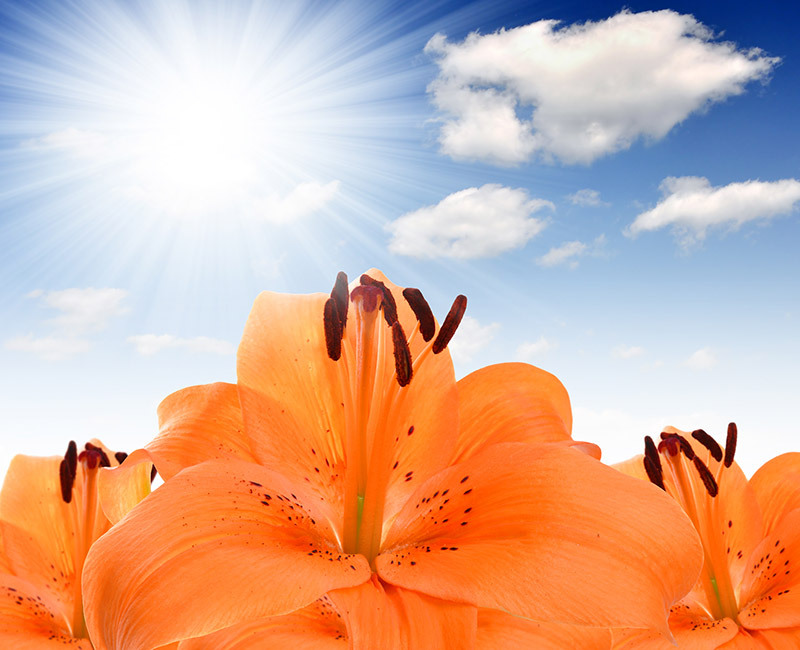New Insights: 7 Facts About Tulips
Posted on 22/08/2025
New Insights: 7 Fascinating Facts About Tulips
The mesmerizing beauty of tulips has made them one of the world's most beloved flowers. Their vibrant colors and elegant shapes brighten gardens, parks, and festivals globally. However, there is more to tulips than their visual appeal. In this comprehensive guide, we delve deep into the world of tulips and uncover 7 facts about tulips that will surprise and inform both budding gardeners and flower aficionados alike. So, let's explore these intriguing tulip insights that showcase the flower's remarkable journey through history, culture, science, and horticulture.

1. Tulips Have Ancient Origins and a Royal Heritage
Did you know tulips are not originally Dutch? Although the Netherlands is synonymous with expansive tulip fields, the history of tulips actually traces back to the foothills of Central Asia, particularly the region now known as Kazakhstan, and parts of northern Iran and China. Wild tulips first grew naturally across these Eurasian steppes.
The Journey from East to West
- First cultivation: The Ottoman Empire began cultivating tulips as early as the 10th century.
- Symbol of power: Tulips became so prized in Turkey that they turned into the Sultan's favorite flower, even featuring on royal garments and palace tiles.
- Tulip festivals: The Turkish capital, Istanbul, still celebrates their tulip heritage every spring with extensive displays.
The word "tulip" is believed to derive from the Persian word for "turban," inspired by the flower's turban-like shape. The tulip's royal legacy brought it to Europe, but it wasn't until Dutch botanist Carolus Clusius planted tulip bulbs in the late 1500s that the Netherlands became the tulip capital of the world.
2. Tulip Mania: The World's First Recorded Economic Bubble
One of the most curious tulip facts concerns "Tulip Mania," a financial phenomenon that swept the Netherlands in the 1630s. The soaring popularity of tulips, especially rare varieties, caused unprecedented price inflation. Some bulbs sold for more than the price of a house!
What Happened During Tulip Mania?
- Speculation fever: The rarest tulip bulbs -- especially those with unique stripes, later found to be caused by a virus -- reached astronomical prices in a speculative craze.
- The crash: In 1637, the market collapsed overnight, leaving many investors penniless. This event is now considered the world's first major financial bubble.
- Enduring legacy: Despite the crash, tulips remained popular and went on to become national Dutch icons.
This dramatic chapter cemented the flower's cultural significance and left a lasting impact on economic history.
3. Over 3,000 Unique Tulip Varieties Exist Worldwide
Modern horticulture has given rise to a staggering array of tulip cultivars. There are now more than 3,000 registered tulip varieties across over 150 species, classified by the Royal General Bulb Growers' Association in the Netherlands.
How Are Tulip Varieties Classified?
- By bloom time: Tulips are divided into early, midseason, and late-flowering groups.
- By flower shape: Shapes range from classic cup and bowl forms to the delicate "lily-flowered" or the frilled petals of "Parrot tulips."
- By color: Tulips come in nearly every color except true blue. Multicolored and variegated blooms are especially prized.
- Special features: Some tulips are scented, others have double petals, and some even sport fringed edges.
Tulip breeders continue to introduce stunning new varieties each year, ensuring that there is always something new and exciting for tulip lovers to discover.
4. Tulips Are a Sign of Spring and Symbolism Around the World
Tulips are among the first flowers to bloom in spring, often pushing through the last of the melting snow. Their arrival is widely seen as a symbol of renewal and hope.
Tulip Symbolism Across Cultures
- In Persia and Turkey: Tulips represent paradise on Earth, perfect love, and the delicate balance of life.
- In Western Europe: They symbolize elegance, abundance, and charity. Red tulips have also become tokens of true love.
- In modern times: In countries like the Netherlands and Canada, tulip festivals celebrate friendship, peace, and international gratitude.
Whether gifted in bouquets or grown in home gardens, tulips convey special meanings in different cultures, enhancing their universal appeal.
5. Tulips Thrive Best in Certain Climates, But Can Be Grown Almost Everywhere
If you are curious about growing tulips, you'll be pleased to know they adapt well to various regions, though they naturally prefer climates with cold winters and cool, wet springs.
Secrets to Successful Tulip Gardening
- Winter chill: Tulips require a period of cool dormancy -- called "vernalization" -- to bloom the following spring.
- Well-drained soil: Soggy soils can cause bulbs to rot.
- Flowering period: Tulips usually flower for 1-2 weeks, but selecting varieties with different bloom times can extend the show for up to six weeks.
- Hardiness: Tulips are typically hardy in USDA Zones 3-7 but can also be grown as annuals in warmer climates by refrigerating bulbs before planting.
Gardeners in nearly any part of the world can enjoy vibrant tulip displays with the right care and a little preparation.
6. Tulips Play a Significant Role in Art, Culture, and Diplomacy
Few flowers have inspired as much creativity and cultural exchange as the tulip. Their unprecedented beauty and symbolism have wired them deeply into global art, literature, and diplomatic history.
The Tulip in Art and Popular Culture
- Art masterpieces: From Ottoman textiles to Dutch Golden Age paintings, tulips have been immortalized by great artists such as Rembrandt and Jan Brueghel the Elder.
- Modern celebrations: Tulip motifs appear on everything from ceramics to fashion, underscoring their enduring popularity.
- International diplomacy: The world-famous Canadian Tulip Festival in Ottawa started as a gesture of gratitude from the Dutch royal family after World War II, when Dutch Princess Juliana sent 100,000 tulip bulbs to Canada.
Through the ages, the tulip has been much more than a mere plant--it has been a muse, a symbol of unity, and a bridge across nations.
7. Some Tulips Are Edible, but Caution Is Required
One of the more surprising facts about tulips is that, under certain circumstances, their petals can be eaten. History shows that during World War II's "Hunger Winter" in the Netherlands, people resorted to eating tulip bulbs to survive. The petals of some tulip species are also used sparingly as garnishes in fine dining.
What to Know About Edible Tulips
- Potential toxins: While some tulip petals are non-toxic, others contain alkaloids that cause stomach upset. The bulbs, in particular, can be poisonous if consumed improperly.
- Flavor profile: Tulip petals generally offer a mild, lettuce-like, or slightly sweet flavor, making them popular as food decorations when researched and prepared safely.
- Allergic reactions: Some individuals may experience skin irritation or allergies from contact with tulips.
- Expert advice: Only consume tulip petals that are confirmed safe to eat and grown without pesticides. Seek advice from a knowledgeable forager or botanist before sampling any tulip parts.
While tulips are admired mostly for their beauty, their place in culinary history speaks to their versatility -- and their role in stories of human resilience.
Bonus: Tips to Make the Most of Your Tulip Experience
- Visit renowned tulip festivals: Don't miss events like the Keukenhof Gardens in the Netherlands, the Canadian Tulip Festival in Ottawa, or Skagit Valley Tulip Festival in the USA.
- Plan your garden: Combine early, mid, and late-blooming varieties for a prolonged display of tulip beauty.
- Try cutting gardens: Tulips make excellent cut flowers. Harvest them in the early morning for longest vase life, and trim stems at an angle.
- Photography tip: For striking photos, take pictures in early morning light or with cloudy skies to bring out tulip colors.

Frequently Asked Questions About Tulips
What is the best way to plant tulip bulbs?
Plant tulip bulbs in the fall, at a depth of 6-8 inches (15-20 cm) and spaced about 4-6 inches (10-15 cm) apart. Ensure the pointed end faces upwards, and plant in well-drained soil for the best results.
How long do tulips bloom?
Most tulip varieties flower for 1-2 weeks. By selecting a combination of early, mid, and late-season tulips, you can enjoy continuous blooms for up to six weeks each spring.
Can tulips grow indoors?
Yes! Tulips can be "forced" to bloom indoors using pots and pre-chilled bulbs. Plant in fertile potting soil, water well, and place in a cool, dark spot until shoots appear, then move to a sunny windowsill.
Do tulips return each year?
Many tulip hybrids are grown as annuals, meaning they are replanted each year. However, species tulips and some perennial varieties can naturalize and return for several years if left undisturbed in the right conditions.
Conclusion
Tulips are much more than just a sign of spring -- they embody history, art, resilience, and international friendship. From their ancient origins in Central Asia to their iconic status in Dutch culture, and their roles in world history and modern gardens, there is always something fascinating to learn about these flowers. The seven facts about tulips shared here represent only a glimpse into the depth and beauty of the tulip world. Whether you're a hobby gardener or a lover of botanical stories, the allure of tulips is truly timeless. Plant some in your garden, give them as a gift, or witness a tulip festival -- and experience these amazing floral wonders firsthand!
Latest Posts
Best Flower Shops Near [LANDMARK/NEIGHBOURHOOD]: A Local's Guide
Discover Easy Flower Preservation for Lasting Beauty
New Insights: 7 Facts About Tulips





